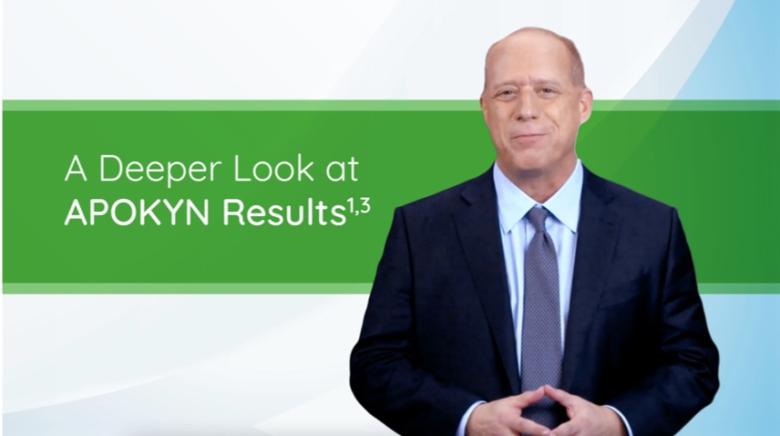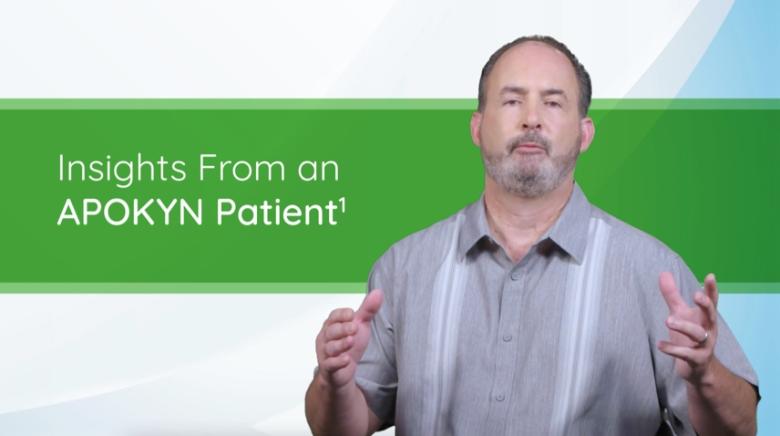INDICATION APOKYN is indicated for the acute, intermittent treatment of hypomobility, “off” episodes (“end-of-dose wearing-off” and unpredictable “on-off” episodes) in patients with advanced Parkinson’s disease (PD). APOKYN has been studied as an adjunct to other medications.
IMPORTANT SAFETY INFORMATION FOR HEALTHCARE PROVIDERS
CONTRAINDICATIONS
Concomitant use of APOKYN with 5HT3 antagonists is contraindicated based on reports of profound hypotension and loss of consciousness Read More
IMPORTANT SAFETY INFORMATION FOR HEALTHCARE PROVIDERS
CONTRAINDICATIONS
Concomitant use of APOKYN with 5HT3 antagonists is contraindicated based on reports of profound hypotension and loss of consciousness when APOKYN was administered with ondansetron.
APOKYN is contraindicated in patients who have demonstrated hypersensitivity/allergic reaction to the drug or any of its excipients (notably sodium metabisulfite). Angioedema or anaphylaxis may occur.
WARNINGS AND PRECAUTIONS
Serious Adverse Reactions After Intravenous Administration: Following intravenous administration of APOKYN, serious adverse reactions including thrombus formation and pulmonary embolism have occurred. APOKYN should not be administered intravenously.
Nausea and Vomiting: Nausea and vomiting, which may be severe, can happen with APOKYN when it is administered at recommended doses. In US clinical studies, 98% of patients were premedicated with trimethobenzamide for 3 days prior to study enrollment and encouraged to continue it for at least 6 weeks. Even with concomitant trimethobenzamide, 31% and 11% and 3% and 2% of APOKYN-treated patients had and discontinued APOKYN due to nausea and vomiting, respectively. As an alternative to trimethobenzamide, consider starting APOKYN therapy at 0.1 mL and titrate based upon effectiveness and tolerance.
Falling Asleep During Activities of Daily Living (ADL) and Somnolence: There have been reports of patients treated with APOKYN who suddenly fell asleep without prior warning of sleepiness while engaged in ADL. If a patient develops significant daytime sleepiness or falls asleep during activities that require active participation, APOKYN should be discontinued. Patients should be advised not to drive or participate in potentially dangerous activities. Patients should be continually reassessed for daytime drowsiness or sleepiness since some events occur well after start of treatment. Somnolence was reported in patients treated with APOKYN.
Syncope/Hypotension/Orthostatic Hypotension: Dopamine agonists, including APOKYN, can cause hypotension, orthostatic hypotension, and syncope. Alcohol, antihypertensive medications, and vasodilating medications may potentiate the hypotensive effect of apomorphine. Patients should avoid alcohol when using APOKYN. Patients taking APOKYN should lie down before and after taking sublingual nitroglycerin.
Falls: Patients with PD are at risk of falling due to underlying postural instability, possible concomitant autonomic instability, and from syncope caused by the blood pressure lowering effects of the drugs used to treat PD. APOKYN might increase the risk of falling by simultaneously lowering blood pressure and altering mobility.
Hallucinations/Psychotic-like Behavior: APOKYN has been associated with new or worsening mental status and behavioral changes, which may be severe, including psychotic-like behavior. Patients with a major psychotic disorder should not be treated with APOKYN.
Dyskinesias: APOKYN may cause dyskinesia or exacerbate pre-existing dyskinesia.
Hemolytic Anemia: Hemolytic anemia requiring hospitalization has been reported and can appear at any time after treatment. Many reported cases included positive Coombs test, suggesting a potential immune-mediated hemolysis. Severe anemia, angina, and dyspnea occurred. Some patients were treated with high dose glucocorticoids or blood transfusions. If a patient develops anemia while taking APOKYN, consider a workup for hemolytic anemia; if it occurs, consider discontinuing APOKYN treatment.
Impulse Control/Compulsive Behaviors: Some people with PD have reported new or increased gambling urges, increased sexual urges, and other intense urges while taking PD medicines, including APOKYN. Because patients may not recognize these behaviors as abnormal, it is important for prescribers to specifically ask patients or their care partners about the development of new or increased gambling urges, sexual urges, uncontrolled spending, or other urges while being treated with APOKYN. Physicians should consider dose reduction or stopping the medication if a patient develops such urges while taking APOKYN.
Cardiac Events: Coronary events— APOKYN reduces resting systolic and diastolic blood pressure and has the potential to exacerbate coronary (and cerebral) ischemia. Therefore, exercise caution when prescribing APOKYN for patients with known cardiovascular and cerebrovascular disease.
QTc Prolongation and Potential for Proarrhythmic Effects: There is a dose-related prolongation of QTc interval after exposure similar to that achieved with therapeutic doses of APOKYN. Drugs that prolong the QTc interval have been associated with torsades de pointes and sudden death. The risks and benefits of APOKYN should be considered prior to initiating treatment with APOKYN in patients with risk factors for prolonged QTc.
Withdrawal-Emergent Hyperpyrexia and Confusion: A symptom complex resembling neuroleptic malignant syndrome (characterized by elevated temperature, muscular rigidity, altered consciousness, and autonomic instability), with no other obvious etiology, has been reported in association with rapid dose reduction, withdrawal of, or change in antiparkinsonian therapy.
Hypersensitivity: Hypersensitivity/allergic reactions characterized by urticaria, rash, pruritus, and/or various manifestations of angioedema may occur because of APOKYN or its sulfite excipient sodium metabisulfite, a sulfite that may cause allergic-type reactions, including anaphylactic symptoms and life-threatening or less severe asthmatic episodes in certain susceptible people. Overall prevalence of sulfite sensitivity in the general population is unknown and probably low; it is seen more frequently in asthmatic than non-asthmatic people.
Fibrotic Complications: Cases of retroperitoneal fibrosis, pulmonary infiltrates, pleural effusion, pleural thickening, and cardiac valvulopathy have been reported with ergot-derived dopaminergic agents. Complete resolution does not always occur when drug is discontinued. Although these reactions are believed to be related to ergoline structure, whether other, non-ergot derived dopamine agonists, such as APOKYN, can cause these reactions is unknown.
Priapism: APOKYN may cause prolonged painful erections in some patients. Although no patients in the clinical studies required surgical intervention, severe priapism may require surgical intervention.
ADVERSE REACTIONS
The most common adverse reactions seen in controlled trials were yawning, drowsiness/somnolence, dyskinesias, dizziness/postural hypotension, rhinorrhea, nausea and/or vomiting, hallucinations/confusion, and edema/swelling of extremities. Injection site reactions, including bruising, granuloma, and pruritus, have been reported.
Please see full Prescribing Information and Pen Instructions for Use/Patient Information.
All trademarks are the property of their respective owners.


